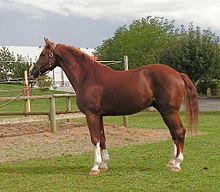Westphalian (horse)
The Westphalian, or Westfalen, is a warmblood horse bred in the Westphalia region of western Germany. The Westphalian is closely affiliated with the state-owned stud farm of Warendorf, which it shares with the Rhinelander. Since World War II, the Westphalian horse has been bred to the same standard as the other German warmbloods, and they are particularly famous as Olympic-level show jumpers and dressage horses. Next to the Hanoverian, the Westphalian studbook has the largest breeding population of any warmblood in Germany.
The history of the Westphalian horse is linked with the State Stud of Warendorf, which was founded in 1826 to serve both the Prussian provinces of Westphalia and Rheinland. The stud was built under the Prussian Stud Administration, which was put together by King Frederick William I in 1713 to improve horse breeding efforts in the German-speaking region. Government-owned studs, identified as "State" or "Principal" studs depending on whether the facility keeps its own herd of mares, purchase stallions that fit the needs of the surrounding region. The stud fees of state-owned stallions are low, enabling local breeders to produce high-quality horses from heavy drafts to riding horses to ponies.
The first stallions to stand at Warendorf were from East Prussia, and so were similar to Trakehners of the time. These horses were riding horses with Thoroughbred blood, suitable for the courtiers to ride and use in cavalry. As the human population between the Rhine and Weser rivers grew, the demand shifted to a medium-heavy all-purpose farm horse to cope with the increase in agriculture. The noble East Prussian stallions were replaced with heavy warmbloods from Oldenburg and East Frisia.
...
Wikipedia

